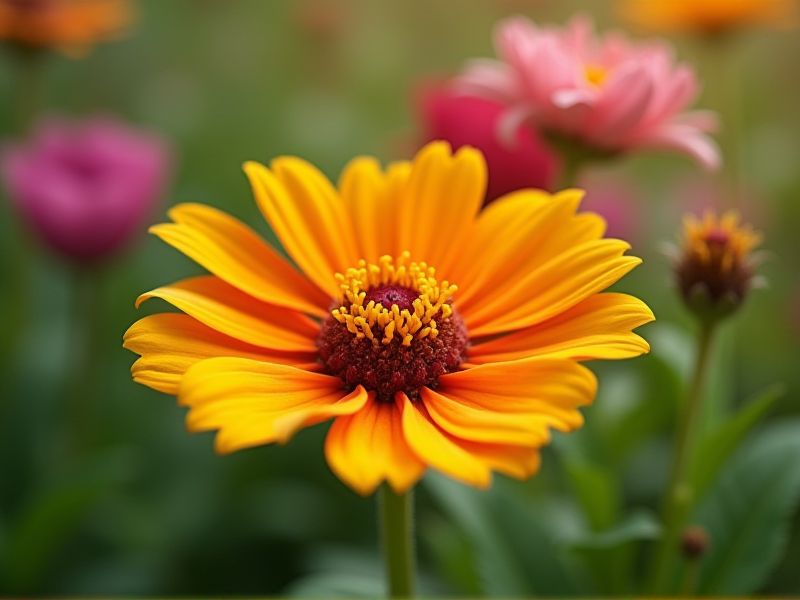
Perennial flowering plants, such as peonies, daylilies, and coneflowers, provide year-after-year blooms, enhancing gardens with vibrant colors and diverse textures. These hardy species often adapt well to various climates, ensuring consistent growth and resilience against seasonal changes. Many perennials are beneficial for local ecosystems, attracting pollinators like bees and butterflies, which play a crucial role in maintaining biodiversity. When planted in optimal conditions, such as well-drained soil and adequate sunlight, they can thrive with minimal maintenance. Incorporating perennial flowers into your landscape not only promotes sustainability but also creates a dynamic and evolving garden space.
List of some Flowering plants that are perennial
- Peony (Paeonia)
- Daylily (Hemerocallis)
- Coneflower (Echinacea)
- Iris (Iris)
- Black-eyed Susan (Rudbeckia)
- Hosta (Hosta)
- Bleeding Heart (Dicentra)
- Lavender (Lavandula)
- Yarrow (Achillea)
- Salvia (Salvia)
Important things about Flowering plants that are perennial
Definition Of Perennial Flowering Plants
Perennial flowering plants are species that live for three or more years, returning each growing season without needing to be replanted. These plants often display vibrant blooms, enhancing garden aesthetics with their colorful flowers over multiple seasons. Unlike annuals, which complete their life cycle in a single year, perennials establish extensive root systems that allow them to survive harsher conditions and bloom year after year. Popular examples include peonies, daylilies, and lavender, each bringing unique foliage and flowers that contribute to diverse landscapes.
Lifespan Characteristics
Perennial flowering plants typically have a lifespan of three years or more, allowing them to bloom year after year. These plants, such as peonies and daisies, enter a dormancy phase during unfavorable conditions, conserving energy for renewed growth in favorable seasons. They develop extensive root systems that enable them to access water and nutrients deep in the soil, contributing to their resilience and longevity. By choosing perennials for your garden, you can create a vibrant landscape that continues to thrive and evolve over time.
Growth Patterns And Cycles
Perennial flowering plants exhibit distinct growth patterns characterized by their ability to return year after year. These plants typically undergo a cycle of dormancy and active growth, allowing them to conserve energy during adverse conditions such as winter. During the growing season, perennials focus on producing flowers, which are crucial for reproduction and attracting pollinators, ensuring the continuation of their species. You can enhance your garden's biodiversity by incorporating a variety of perennial species, as they offer more stability and reduce the need for annual replanting.
Root Systems And Adaptations
Perennial flowering plants exhibit diverse root systems that enhance their survival and adaptability in various environments. Deep taproots allow these plants to access water and nutrients from below the surface, which is especially beneficial during drought conditions. Furthermore, fibrous root systems can cover large areas of soil, increasing stability and aiding in soil erosion prevention. Understanding these root adaptations can guide you in selecting the right perennial plants for your garden or landscape, ensuring sustainable growth and resilience.
Flowering Seasons And Timing
Perennial flowering plants generally bloom in cycles, with many species displaying their vibrant flowers during specific seasons. For instance, spring-blooming perennials like daffodils and tulips emerge as the weather warms, while summer-blooming varieties such as coneflowers and daylilies showcase their colors from late spring through summer. Fall-blooming perennials, including asters and chrysanthemums, provide late-season interest as they flower before winter dormancy. Understanding the timing of these flowering seasons can greatly enhance your garden's visual appeal and ensure a continuous display of blooms throughout the year.
Common Examples Of Perennial Flowering Plants
Perennial flowering plants, such as Echinacea (coneflower), Lavandula (lavender), and Helleborus (hellebore), return year after year, offering vibrant blooms and essential beauty to gardens. These plants often thrive in a range of climates and soil types, making them versatile choices for any landscaping project. You can find them in various species and colors, creating an appealing seasonal display that supports local pollinators. Incorporating these perennials into your garden can enhance biodiversity and reduce maintenance, as they typically require less care compared to annual plants.
Care And Maintenance Requirements
Perennial flowering plants thrive with proper care, ensuring vibrant blooms year after year. Regular watering, particularly during dry spells, keeps the soil consistently moist but never soggy, promoting healthy root systems. Utilizing organic mulch not only conserves moisture but also suppresses weeds, allowing your perennials to flourish. Pruning dead or faded flowers encourages new growth and extends the blooming season, ensuring your garden remains colorful and lively.
Environmental Preferences And Habitat
Perennial flowering plants thrive in a variety of environmental conditions, making them adaptable to diverse habitats such as woodlands, meadows, and gardens. These plants typically require well-drained soil and adequate sunlight to promote healthy growth and vibrant blooms. To enhance your garden's ecosystem, consider integrating native perennials that attract pollinators like bees and butterflies, fostering biodiversity. Understanding the specific light, moisture, and soil requirements of these plants will ensure their successful establishment and longevity in your landscape.
Benefits To Ecosystems And Wildlife
Perennial flowering plants, such as lavender and coneflower, significantly contribute to ecosystem stability by providing year-round sources of nectar and pollen for pollinators like bees and butterflies. These enduring plants help maintain soil health through their extensive root systems, reducing erosion and enhancing nutrient cycling. In addition, they create habitats for various wildlife species, fostering biodiversity and promoting ecological resilience. By integrating perennial flowering plants into your garden or landscape, you support local ecosystems and increase the overall health of the environment.
Propagation Methods And Techniques
Propagation methods for perennial flowering plants include division, cuttings, layering, and seed sowing. Division involves separating the root clumps of established plants, allowing for easy transplantation and growth of new specimens. Cuttings can be taken from stems, leaves, or roots, promoting root development in a suitable medium, while layering encourages a branch to root while still attached to the parent plant. Seed sowing requires germination conditions tailored to the specific perennial, ensuring successful establishment in your garden.
